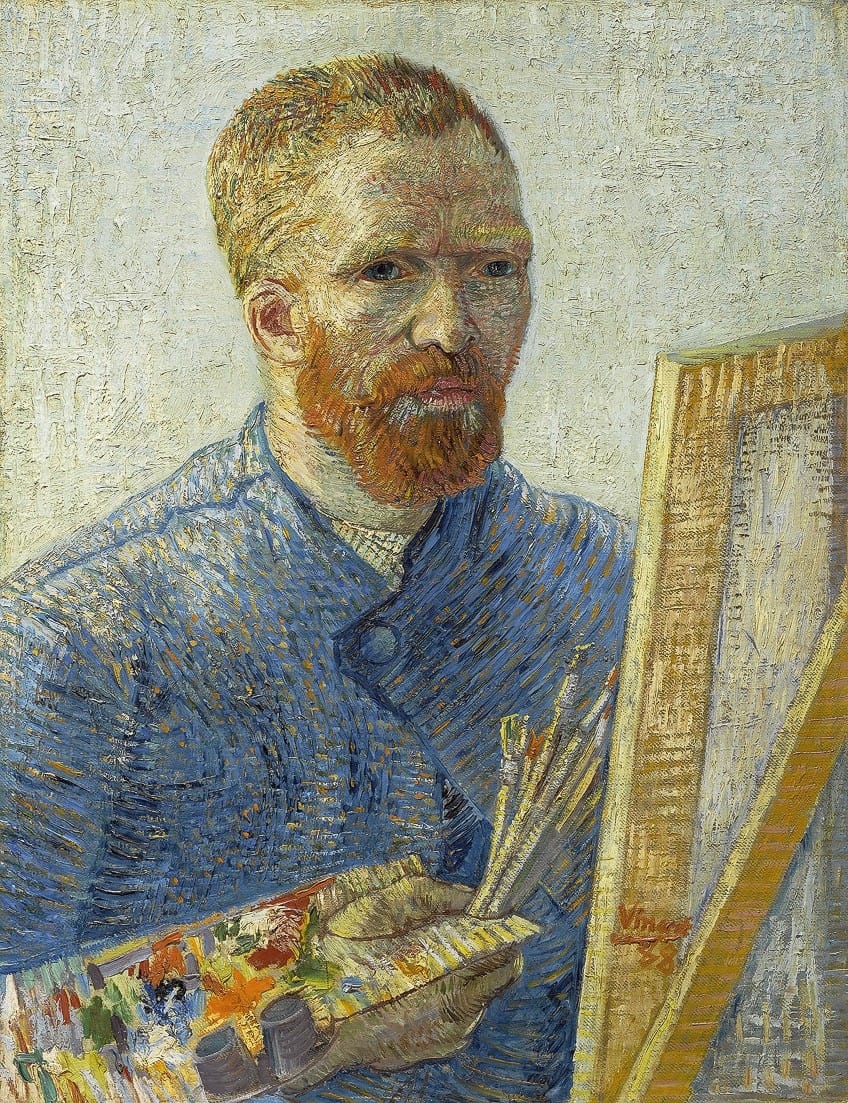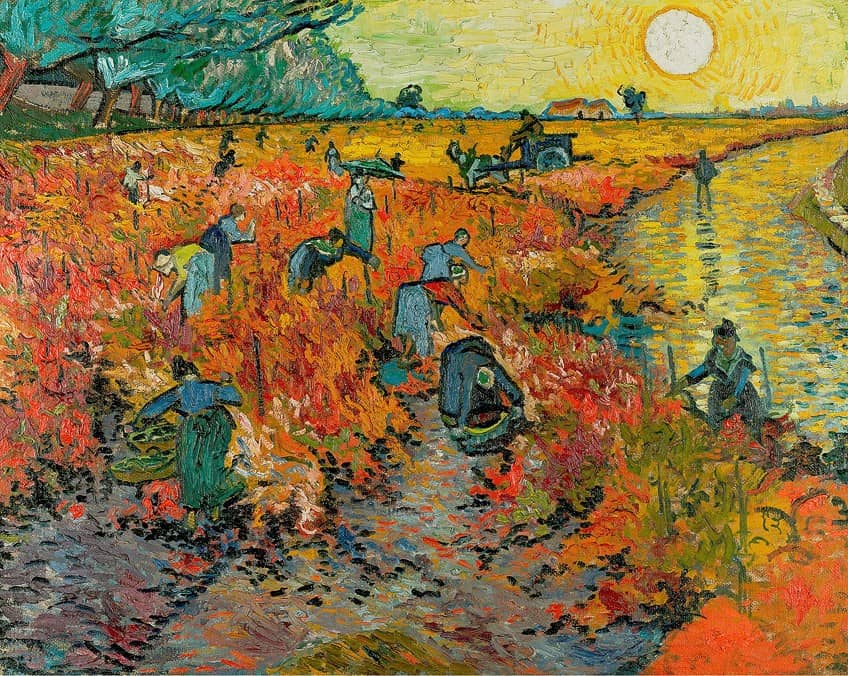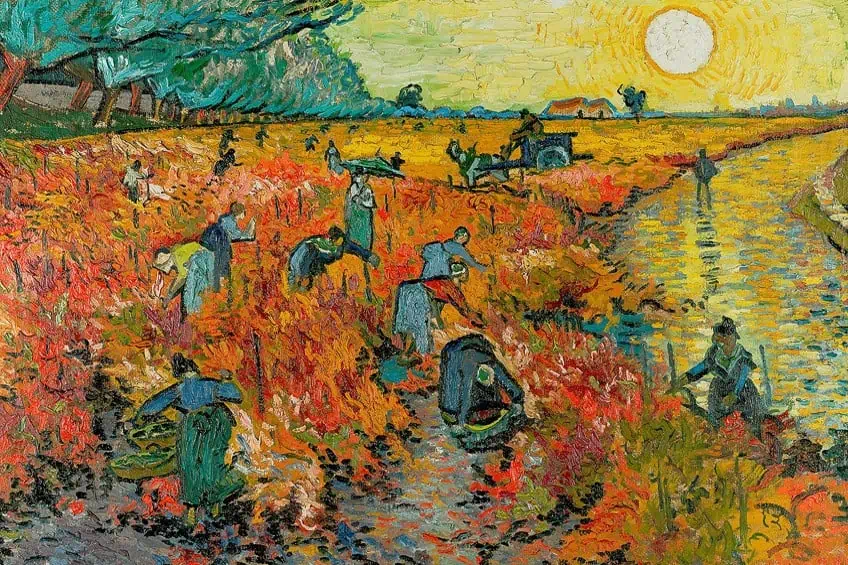“The Red Vineyard” by Vincent van Gogh – A Stroke of Brilliance
What painting did Van Gogh sell in his lifetime? The Red Vineyard by Vincent van Gogh is often cited as the only artwork that the Dutch painter ever managed to sell. However, some scholars believe that he sold a few paintings before he produced The Red Vineyard painting. To learn more about these different theories, check out The Red Vineyard analysis and history below!
Understanding The Red Vineyard by Vincent van Gogh
| Artist Name | Vincent van Gogh (1853 – 1890) |
| Date Completed | 1888 |
| Medium | Oil on canvas |
| Dimensions (cm) | 75 x 93 |
| Location | The Pushkin State Museum of Fine Arts, Moscow, Russia |
There is much speculation surrounding the claim that The Red Vineyard painting was the only artwork to be sold by the Dutch artist in his own lifetime. This claim most likely arose due to the fact that it was the only work to have been officially sold, therefore its sale and name were documented.
Yet, this doesn’t necessarily mean that he didn’t sell any works privately prior to this sale.
In any case, it was a very small amount of sales for such a talented artist who deserved much more recognition than he received while still alive. Yet, after his death only a few years later, this Van Gogh work, along with many others, would come to be recognized as the work of a master.
A Little Introduction to Vincent van Gogh
| Artist Name | Vincent Willem van Gogh |
| Nationality | Dutch |
| Date of Birth | 30 March 1853 |
| Date of Death | 29 July 1890 |
| Place of Birth | Zundert, the Netherlands |
One has to keep in mind, though, that the artist only started painting when he was in his late 20s and committed suicide around 10 years later. While he may have been rather prolific during this period, he did not reach the public acknowledgment that one would expect from an artist of his caliber. This is most likely because he was a rather depressed and isolated figure who suffered from various mental illnesses and preferred to live away from the hustle and bustle of the Parisian art world, where he had stayed with his brother from 1886 to 1888.
He preferred to stay in the countryside, such as in Arles, where he produced many famous works, such as The Red Vineyard painting.
He loved the country life and the landscapes so much that he wanted to start an artist’s colony there, hoping that the other Post-Impressionists would move there and join him. However, this was not to be, and the only person who ended up joining him there was Paul Gauguin. The Dutch painter had met Gauguin two years before and was awestruck by the somewhat older painter.

Even his stay was relatively short-lived, and after around two months, things grew heated between the two, resulting in Gauguin leaving and Van Gogh mutilating himself. Van Gogh subsequently admitted himself into a mental asylum after repeated breakdowns in his mental health. But, before doing so, he produced many notable artworks while staying in Arles. Let us find out more about one of the most significant of these works, The Red Vineyard painting.
The Red Vineyard History
Vincent van Gogh received an invitation to show his work at the Les XX exhibition in Brussels in 1889. He recommended to his brother, who was acting as his art agent, that he submit six works of art to the exhibition, one of which being The Red Vineyard painting. The art collector and artist from Belgium, Anna Boch, paid 400 Belgian francs for the artwork the following year.
In a subsequent letter to his brother about the transaction, Van Gogh stated, somewhat embarrassed, that she had paid the price as displayed at the Les XX 1890 Exhibition when he should have given her a friend’s price.
Maybe she admired the artwork and wanted to demonstrate her support for the artist, whose art was receiving heavy criticism at the time; maybe she wanted to support him as he was struggling financially; or maybe she was just doing it to make Eugène, her brother happy, as he was a good friend of the artist. Eugène was also an artist and had gone to visit the Dutch painter in Arles in 1888. The two artists became good friends, and Van Gogh created a portrait of him, which hung for some time in Van Gogh’s room in the Yellow House.

Eugène apparently owned several Van Gogh artworks and his sister owned two. In 1906, Anna sold the painting for 10,000 francs. The primary reason she ended up selling the painting was so that she could buy more artworks, mostly by Paul Signac. The painting was then sold again that same year to Sergei Shchukin, a businessman from Russia. After Lenin approved legislation allowing them to collect all artworks, the work of art became the property of the Soviet Union state. From 1918 until 1948, it was kept at the State Museum of Western Art. In 1948, It was presented to the Pushkin Museum by the state of Russia.
The State Museum of Western Art was then shut down by Stalin in 1948. This is why the painting was then moved to the Pushkin Museum.
The Red Vineyard Analysis
Van Gogh usually painted what he saw in front of him, believing that he created his best work by doing so. Yet, this painting was produced from memory at the time when Gauguin was staying with him. It features a dramatic landscape rendered in intense autumnal yellows and reds, with vineyard workers in blue clothing laboring among the vines. The artwork represents rural viticultural methods: a north-facing vineyard, filled with extending vines, wooden baskets, carts, and female harvesters hand-picking grapes.
One can see the bright yellow sun and sky reflecting off of the surrounding river. In a letter to his brother, Van Gogh wrote that they had seen a most beautiful vineyard that Sunday and that he had begun a painting of it.

He also mentioned that Gauguin was working on a painting from memory, which may have perhaps inspired him to try to do the same. He further said that he wanted to start painting from memory more as it freed the work of the awkwardness associated with painting from nature and gave the work a more artistic aesthetic. The vineyards not only provided a beautiful landscape for the artist to portray, but they also produced one of the artist’s favorite vices, wine. It is believed that he consumed a fair amount of wine in Arles, which fueled his productivity, producing over 200 paintings as well as around 100 drawings.
He wrote in one of his letters that he was following the remedy for suicide that Dickens had suggested, which consisted of bread, cheese, a pipe of tobacco, and, of course, wine.
What Painting Did Van Gogh Sell When Alive?
The idea that this was van Gogh’s only artwork sold during his lifetime has been refuted by a respected van Gogh historian. The idea that this was Van Gogh’s only artwork sold during his lifetime has been refuted by Marc Edo Tralbaut, a respected Van Gogh historian. He discovered a letter written by Van Gogh’s brother to Sulley and Lori, the art dealers in London dated the 3rd of October 1888. In the letter, his brother wrote that the paintings the dealers had purchased had been sent, one of which was a Camille Corot landscape, and the other a Van Gogh portrait.
Yet other scholars who have studied the contents of the letter believe that he might have written the wrong date on the letter.
The dealers Sulley and Lori had not yet formed a partnership in 1888 and their records show no documentation of a landscape by Corot being bought in that year. However, this one letter is not enough proof to indicate whether he sold any other works, only that one may have been sold by his brother to the dealer at some point, perhaps even after his death. Yet, the official website of the Van Gogh Museum states that he actually traded or sold several paintings personally while he was still alive.
Van Gogh’s first commissioned work came from his art dealer uncle. He commissioned a series of 19 paintings of The Hague to help advance his nephew’s budding art career. Van Gogh, especially when he started off, would exchange artwork for art supplies or food, a practice common among young painters just starting out. According to the museum’s head curator, Van Gogh further indicates in his own letters that he sold one of his portraits to someone, though it is not known who the portrait was for.
Van Gogh passed away in July 1890. After the artist died, his brother’s biggest aim was to make his work more widely recognized, but he passed away six months later from syphilis. Luckily, Van Gogh’s sister-in-law made sure the artworks were looked after. It was her son, also named Vincent, who would go on to establish the Van Gogh Museum, where many of his most famous works were put on display. However, unlike all of these works that had stayed in the family’s possession, The Red Vineyard painting has the distinction of being the only officially documented sale of a work in the artist’s own lifetime. Yet, besides this official sale, even the Van Gogh Museum itself has stated that there were likely other works sold by the artist, especially to family members, such as his uncle, who was an art dealer. The Red Vineyard by Vincent van Gogh is still the only work that has ever been authenticated as being sold in his lifetime, though.
Frequently Asked Questions
What Painting Did Van Gogh Sell While He Was Still Living?
There is much debate about whether Van Gogh sold more than one painting while he was still alive. Some scholars state that the only work ever officially recognized as being sold was The Red Vineyard painting, one of six works that he entered into the Les XX exhibition in 1889. The work was subsequently bought by Anna Boch, whose brother, Eugene, had once visited the artist in Arles. Other scholars claim that Van Gogh had already sold 19 works to his uncle early in his career, and that he often traded works for food and supplies.
What Is The Red Vineyard Painting About?
This was among the artworks produced by Van Gogh during his time in Arles, France. It depicts a vineyard landscape based on a scene he had once observed while out with Paul Gauguin. He did not paint it from life though, and produced it from memory back in his studio. It depicts workers in a vineyard next to a river that reflects the yellow sun. It is often regarded as the only work that the artist sold while still alive, yet this claim has been disputed.
Jordan Anthony is a Cape Town-based film photographer, curator, and arts writer. She holds a Bachelor of Art in Fine Arts from the University of the Witwatersrand, Johannesburg, where she explored themes like healing, identity, dreams, and intuitive creation in her Contemporary art practice. Jordan has collaborated with various local art institutions, including the KZNSA Gallery in Durban, the Turbine Art Fair, and the Wits Art Museum. Her photography focuses on abstract color manipulations, portraiture, candid shots, and urban landscapes. She’s intrigued by philosophy, memory, and esotericism, drawing inspiration from Surrealism, Fluxus, and ancient civilizations, as well as childhood influences and found objects. Jordan is working for artfilemagazine since 2022 and writes blog posts about art history and photography.
Learn more about Jordan Anthony and about us.
Cite this Article
Jordan, Anthony, ““The Red Vineyard” by Vincent van Gogh – A Stroke of Brilliance.” artfilemagazine – Your Online Art Source. November 9, 2023. URL: https://artfilemagazine.com/the-red-vineyard-by-vincent-van-gogh/
Anthony, J. (2023, 9 November). “The Red Vineyard” by Vincent van Gogh – A Stroke of Brilliance. artfilemagazine – Your Online Art Source. https://artfilemagazine.com/the-red-vineyard-by-vincent-van-gogh/
Anthony, Jordan. ““The Red Vineyard” by Vincent van Gogh – A Stroke of Brilliance.” artfilemagazine – Your Online Art Source, November 9, 2023. https://artfilemagazine.com/the-red-vineyard-by-vincent-van-gogh/.



